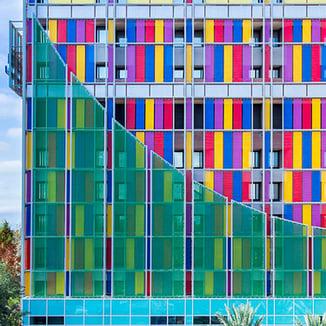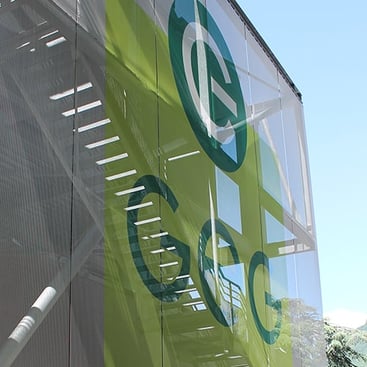Paint vs. Digital Print: Choosing the Best Architectural Mesh Coating
Architects often seek new and innovative ways to enhance their architectural design process. At the same time, they look for an even balance between innovation and cost savings.
Architectural wire mesh provides a unique way to find the balance as it provides a one-of-a-kind look that can be coated to accommodate any branding and logo needs. That being said, it is important the right coating, whether paint or digital print, is applied when necessary?
Specializing in both the painting and digital printing of architectural mesh, W.S. Tyler is here to ensure your final product best reflects the vision you had.
This article will provide insight into what it means to paint architectural wire mesh, what it means to digitally print architectural wire mesh, and why you may want to use one over the other.
What Does It Mean To Paint Architectural Mesh?
 Painting is the process in which a color, pattern, or graphic is spray painted onto the mesh using automotive-grade paint. Automotive-based paints are used because it provides enough elasticity to allow the mesh to be rolled and unrolled without the paint chipping or cracking.
Painting is the process in which a color, pattern, or graphic is spray painted onto the mesh using automotive-grade paint. Automotive-based paints are used because it provides enough elasticity to allow the mesh to be rolled and unrolled without the paint chipping or cracking.
This is why other coatings, such as powdered coatings, can’t and shouldn't be used.
Having said that, there are little to no limitations to paint in terms of what it can do. It can be used to match any color within the RAL or Pantone color spectrum. When it comes to graphic and logo application, imagery can be matched down to a 2-inch detail as long as it is accompanied by a detailed vector image.
Best of all, the paint won’t tarnish, discolor, or form a patina.
What Does the Painting Process Look Like?
Once the mesh panel is properly woven, the areas of the mesh that are not being painted are masked off. This is especially important when incorporating a graphic as this is a fundamental step in capturing the desired level of detail.
A special primer is then applied to all the areas that will be painted to ensure the paint adheres to the stainless steel wires.
The colored paint is then applied on top of the primer, carefully following the customer’s requests. Once the colored paint is applied, a clear, protective coating is applied in efforts to protect the paint from weather and other potentially harmful elements.
NOTE: Paint can be applied to both the front and back of the mesh panel.
What Does It Mean To Digitally Print Architectural Mesh?
Digital printing is the process in which the mesh panel is run through a printer to transpose a form of imagery on mesh panels.

By digital printing, complex graphics and pictures can be applied to the architectural wire mesh. Even photos and very detailed pictures can be displayed. How well the graphic or image can be viewed ultimately depends on the selected mesh profile and, naturally, the viewing distance.
What Does the Digital Printing Process Look Like?
Digitally printing mesh is very similar to digitally printing a piece of paper. Once the mesh is woven and off the loom, it is loaded into a digital printer.
At this point the digital printer begins to transfer ink onto the mesh and the image slowly comes to life. As this application is similar to the printing we use on paper, there is no need for masking.
After the imagery is transferred, an additional UV-resistant protective coating is applied if the mesh is being used for exterior applications. This coating is designed to protect the graphic from the elements of the surrounding environment.
NOTE: Unlike painting, you can only digitally paint the front side of your mesh.
When Should My Mesh Be Painted?
If you are working with a larger wire mesh panel, such as a parking structure, painting will be your best option. This is because digital printing is predominantly used when attempting to capture the extremely fine details of an image.
These fine details tend to be difficult for viewers to render on larger panels, especially from a far distance.
To put this into perspective, let’s say your graphic includes the eyelashes of a person. If you want these eyelashes to be viewable from far away, each eye lash needs to be at least 4 to 5 inches.
Digital printing is used for application that would call for the eye lashes to be 2 inches in detail.
To put it simply, paint should be used when trying to cover larger mesh panel applications. Painted architectural wire mesh panels are great for exterior applications that need more color and added excitement.
When Should My Mesh Be Digitally Printed?
Digital printing provides a means of transposing an image with an extreme amount of detail with true color. Putting it simply, it allows architects to capture the “real feel” the imagery is attempting to convey.
Because the imagery detailing can be so fine, digital printing is typically only applied when the mesh is used for interior applications. This is because when applied to larger, exterior applications a lot of the detail will be lost when viewed from afar.
That said, there are limitations to the size of the mesh panels that can be put through a digital printer. If your mesh panel exceeds 10’x20’ then explore painting as an option.
How Long Will Painted/Digital Printed Images Last?
No matter which method you use, the imagery will last as long as the mesh system itself. As each wire mesh system is designed to last the lifetime of the structure, this means the imagery will always be there until the mesh is taken off the structure.
That said, it should be noted that once the mesh is painted, it’s painted permanently. You can not take the paint off and reapply a new graphic or updated logo.
How Does Painting and Digital Printing Affect Cost?
As painting and digital printing are additional services, applying either to your mesh will add on to the price of each panel that is altered. That said, both applications are identical in price.
When working with flat or solid colors, such as your reds, blues, and greens, you should expect to pay around $10 per square foot. Metallic colors, on the other hand, are more expensive and cost around $15 per square foot on average.
These costs are only applied to the panels that are being painted/digitally printed and will not include the areas that are not. Best of all, these prices remain the same regardless of the amount of colors or detail needed to achieve the desired look.
Now, it's important to know that both methods provide a means of eliminating signage packages. If a logo or any sort of branding needs to be applied to your building, you can use paint or digital print to apply it directly to the mesh.

In turn, the need to punch out holes for sign mounting or any further fabrication to accommodate additional branding is also eliminated. This ultimately saves a lot of money, allowing you to reallocate funds towards other elements of the project.
Expand Your Knowledge on Architectural Mesh and Become an Expert
The application of paint or a digital print to architectural wire mesh panels is a great method to create an aesthetic that awes onlookers for years. Paint adds color, excitement, and flair to larger mesh panels whereas digital print allows you to achieve highly detailed images that feature true color on smaller mesh panels.
Knowing which one to use can be confusing but ultimately comes down to the size of the mesh panels and the effect you wish to achieve. That said, the coating you apply to your wire mesh panels is just the tip of the iceberg when it comes to creating the perfect architectural design solution.
With over 20 years of experience working with both painted and digitally printed mesh, W.S. Tyler is here to help you select the right solution for your particular needs.
To learn everything you need to know about architectural mesh, refer to our Architectural Wire Mesh product guide.
About Ronnie Brown
Ronnie is the Content Writer for W.S. Tyler and has four years of experience as a professional writer. He strives to expand his knowledge on all things particle analysis and woven wire mesh to leverage his exceptional writing and graphic design skills, creating a one-of-a-kind experience for customers.




